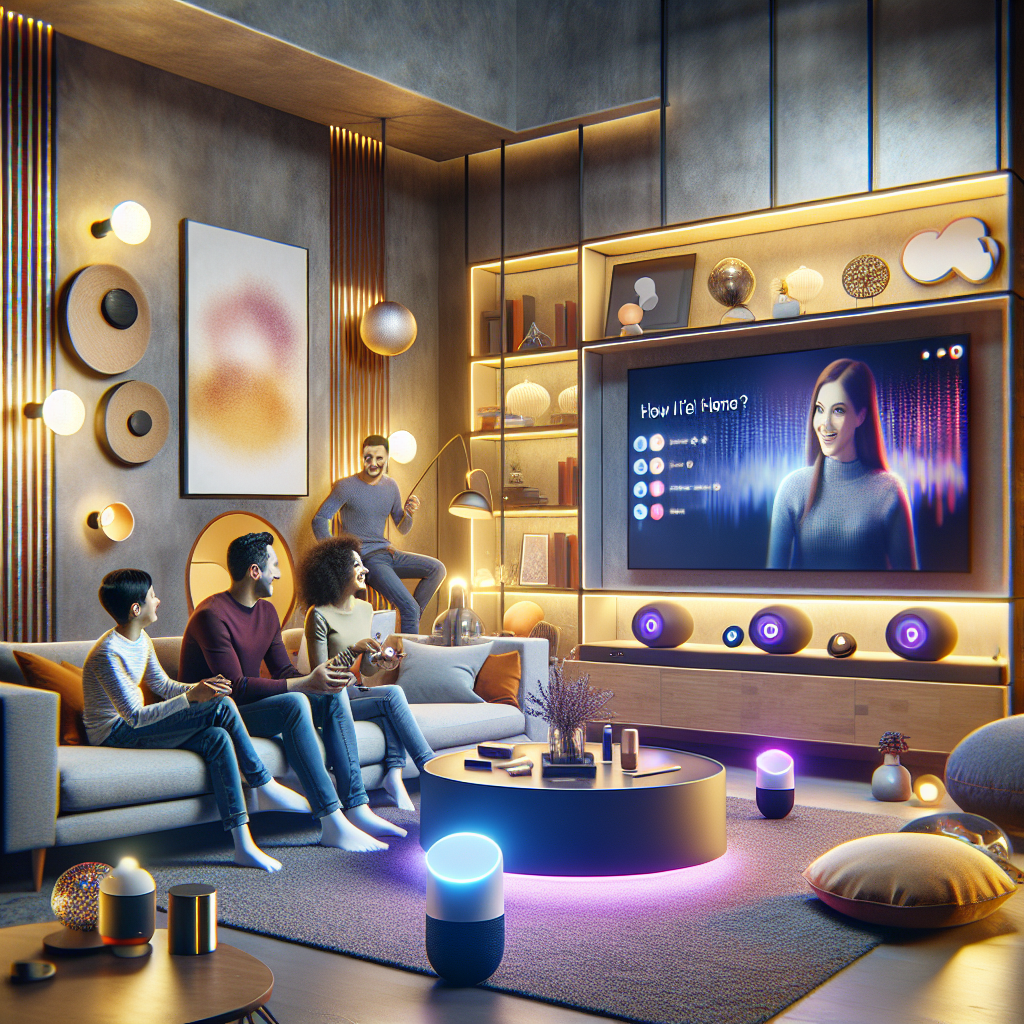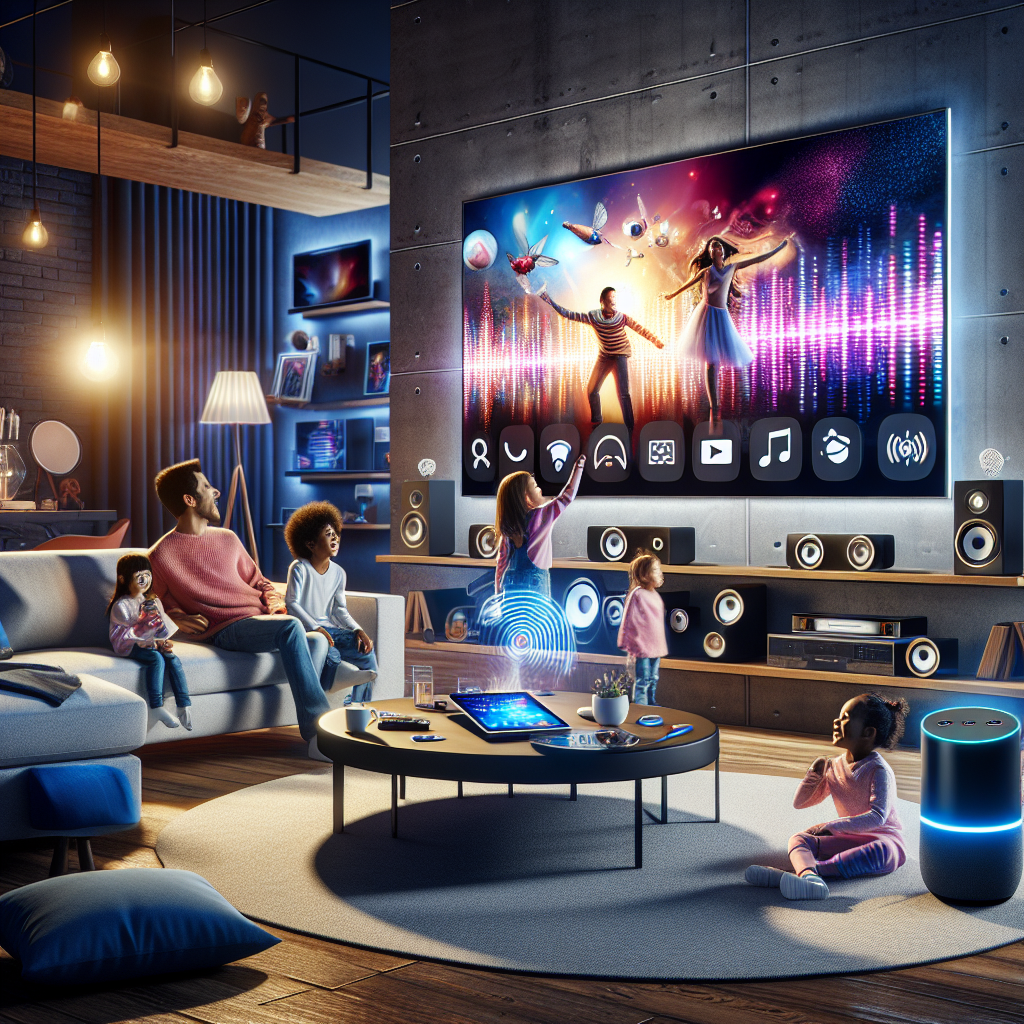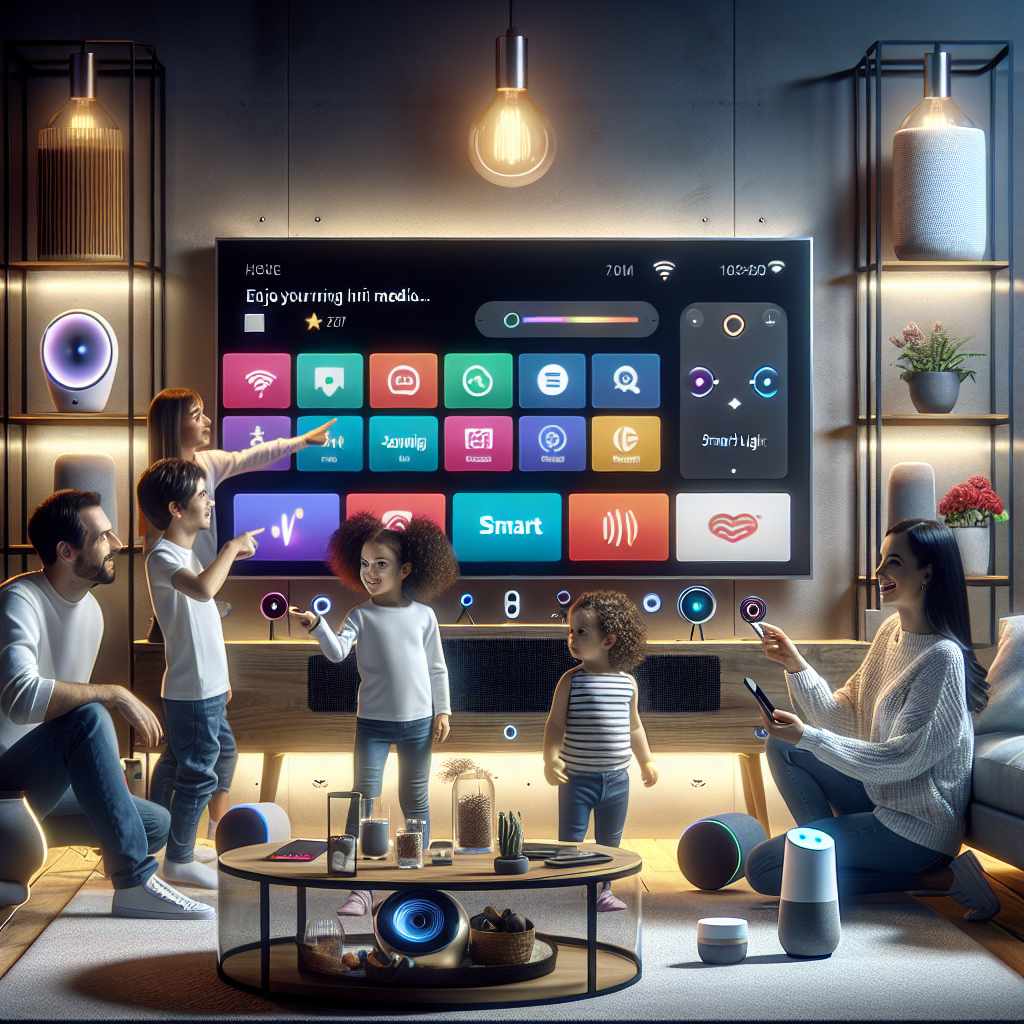In the exciting realm of entertainment, smart home devices are reshaping the way we experience media in our living spaces. From voice-activated speakers to high-definition projectors, these innovative gadgets are revolutionizing the way we enjoy movies, music, and games from the comfort of our homes. With the integration of AI technology and advanced connectivity, smart home devices are creating immersive entertainment experiences like never before. Join us on a journey as we explore the future of entertainment and delve into the endless possibilities that smart home devices offer for enhancing our viewing and listening pleasure. Get ready to be amazed by the future of entertainment in your own home.
Understanding Smart Home Devices for Entertainment

Smart home devices refer to electronic gadgets and appliances that can connect to the internet and be controlled remotely. In the entertainment sector, these devices have evolved significantly, offering a seamless and personalized experience for users.
-
Definition of smart home devices
Smart home devices encompass a wide range of products, including smart TVs, streaming devices, smart speakers, and lighting systems. These devices are equipped with sensors, processors, and wireless communication technology to enable connectivity and automation. -
Evolution of smart home technology in the entertainment sector
The integration of smart home technology in entertainment has transformed how individuals consume media. From voice-activated controls to personalized recommendations based on user preferences, smart home devices have revolutionized the way we interact with entertainment content. -
Benefits of incorporating smart home devices for entertainment purposes
By incorporating smart home devices into entertainment setups, users can enjoy a more immersive and convenient viewing experience. These devices allow for seamless streaming, voice commands for hands-free operation, and the ability to create customized entertainment environments tailored to individual preferences.
Types of Smart Home Devices for Entertainment
Understanding Smart Home Devices for Entertainment
- Smart TVs
- Smart TVs are internet-connected televisions that allow users to stream content from various online platforms such as Netflix, Hulu, and Amazon Prime.
- These devices often come equipped with voice control capabilities, high-resolution displays, and advanced features like screen mirroring and app integration.
-
Smart TVs have revolutionized the traditional television viewing experience by providing access to a wide range of entertainment options without the need for additional devices.
-
Streaming devices
- Streaming devices like Roku, Apple TV, and Chromecast are compact devices that connect to a TV’s HDMI port and enable users to stream content from the internet.
- These devices offer access to popular streaming services, live TV channels, and on-demand content, providing users with a versatile entertainment experience.
-
Streaming devices have become increasingly popular due to their affordability, ease of use, and ability to transform any standard TV into a smart entertainment hub.
-
Smart speakers
- Smart speakers such as Amazon Echo and Google Home are voice-activated devices that not only play music but also serve as central hubs for controlling other smart home devices.
- These devices can stream music from various online services, provide weather updates, set reminders, and answer questions using artificial intelligence.
-
Smart speakers have integrated entertainment into the fabric of daily life, offering seamless access to music, podcasts, audiobooks, and radio stations with simple voice commands.
-
Gaming consoles
- Gaming consoles like PlayStation, Xbox, and Nintendo Switch are powerful entertainment devices that not only offer immersive gaming experiences but also serve as multimedia hubs.
- These devices can stream content from popular services like Netflix, Hulu, and YouTube, in addition to playing physical and digital games.
-
Gaming consoles have evolved beyond traditional gaming to provide a comprehensive entertainment solution, catering to users’ diverse interests and preferences.
-
Smart lighting systems
- Smart lighting systems, such as Philips Hue and LIFX, enable users to customize the ambiance of their entertainment spaces through adjustable lighting settings.
- These systems can be controlled remotely via smartphone apps, voice commands, or automated schedules, allowing users to create personalized lighting effects for different activities.
- Smart lighting systems enhance the entertainment experience by setting the mood for movie nights, gaming sessions, or relaxing evenings, adding a dynamic element to home entertainment setups.

Enhancing Entertainment Experiences with Smart Home Devices
Smart home devices have significantly transformed the way individuals interact with and enjoy media content within the comfort of their own homes. Through the integration of advanced technologies, these devices offer a range of features that enhance entertainment experiences, making them more personalized, immersive, and convenient.
- Integration of Voice Commands for Seamless Control
One of the key aspects of smart home devices is their integration of voice command capabilities. Users can now effortlessly control their entertainment systems using voice prompts, eliminating the need for manual input or remote controls. This hands-free approach not only simplifies the user experience but also adds a layer of interactivity, allowing individuals to navigate through different media options with ease.
- Personalized Recommendations and Content Curation
Smart home devices leverage artificial intelligence and machine learning algorithms to analyze user preferences and behavior patterns. By collecting data on viewing habits, listening preferences, and content consumption, these devices can offer personalized recommendations tailored to individual tastes. This level of content curation ensures that users are presented with media that aligns with their interests, ultimately enhancing their overall entertainment experience.
- Multi-Room Audio Systems for Immersive Sound Experiences
Another notable feature of smart home devices is the ability to create multi-room audio systems. By connecting speakers in different rooms throughout the house, users can enjoy synchronized audio playback, creating a seamless and immersive sound experience. Whether listening to music, watching movies, or playing games, the synchronized audio enhances the depth and richness of the sound, enveloping users in a surround-sound environment that adds a new dimension to their entertainment activities.
Customizing Entertainment Settings
In the realm of smart home devices, customization plays a pivotal role in transforming entertainment experiences. Here’s how individuals can tailor their entertainment settings to suit their preferences:
-
Setting up smart home devices for individual preferences: Smart home devices such as voice-controlled assistants, smart TVs, and lighting systems can be personalized to cater to individual entertainment needs. Users can adjust settings like display brightness, sound levels, and ambient lighting to create a personalized entertainment environment.
-
Creating scenes for different entertainment moods: With smart home technology, users can create customized scenes for various entertainment moods. Whether it’s a cozy movie night, a lively party atmosphere, or a relaxing reading session, smart devices can be programmed to adjust settings like lighting color, sound profiles, and temperature to set the desired mood.

– Automating entertainment systems for convenience: Automating entertainment systems through smart home devices offers unparalleled convenience. Users can schedule specific entertainment setups to activate at certain times or in response to triggers like voice commands or motion detection. This automation not only enhances the entertainment experience but also simplifies the process, allowing users to focus on enjoying their media content.
Addressing Security Concerns with Smart Home Entertainment
In the realm of smart home entertainment, ensuring the security of devices is paramount to safeguarding personal privacy and preventing unauthorized access to sensitive data. Here are some key strategies for addressing security concerns with smart home entertainment systems:
- Importance of securing smart home devices
- Smart home devices, including TVs, speakers, and streaming platforms, are vulnerable to cyber threats if not properly secured.
-
Unauthorized access to these devices can lead to privacy breaches and potential data misuse.
-
Implementing encryption and authentication protocols
- Encryption protocols such as SSL/TLS can help protect data transmitted between smart devices and servers.
-
Two-factor authentication adds an extra layer of security by requiring users to provide a secondary form of verification.
-
Regular software updates for enhanced security features
- Manufacturers should regularly release software updates to patch security vulnerabilities that could be exploited by hackers.
- Users should promptly install these updates to ensure their smart home devices are equipped with the latest security features and protections.
Educating Users on Data Privacy
As smart home entertainment systems become more integrated into daily life, it is crucial to educate users on the importance of data privacy to prevent potential security breaches and unauthorized access to personal information. By understanding the data collection practices of smart home devices, users can make informed decisions about the information they share and the settings they enable on their devices.
Key points to consider when educating users on data privacy include:
-
Data Collection Transparency: Users should be aware of the types of data being collected by their smart home devices, such as voice commands, viewing habits, or device usage patterns. This transparency can help users evaluate the level of privacy they are comfortable with and adjust settings accordingly.
-
Privacy Settings: Smart home devices often come with privacy settings that allow users to control how their data is used and shared. Educating users on how to access and customize these settings can empower them to protect their privacy effectively.
-
Consent and Compliance: It is important for users to understand the importance of giving informed consent for data collection and processing. This includes being aware of data protection regulations such as the General Data Protection Regulation (GDPR) and ensuring that smart home devices comply with these laws.
-
Security Measures: Educating users on the security measures in place to safeguard their data, such as encryption protocols and secure authentication methods, can increase their trust in smart home entertainment systems and encourage responsible use of these devices.
By fostering a culture of data privacy awareness and providing users with the knowledge and tools to protect their personal information, the future of entertainment through smart home devices can continue to evolve in a safe and secure manner.
Future Trends in Smart Home Entertainment
Integration of Artificial Intelligence for Predictive Entertainment Suggestions
- Smart home devices are increasingly incorporating artificial intelligence algorithms to analyze users’ viewing habits and preferences.
- By leveraging AI, these devices can offer personalized recommendations for movies, TV shows, music, and other forms of media.
- This predictive capability enhances the overall entertainment experience by introducing users to content tailored to their interests, ultimately saving time and effort in searching for new entertainment options.
Expansion of Virtual and Augmented Reality Experiences
- The future of smart home entertainment is set to embrace virtual and augmented reality technologies, providing immersive experiences like never before.
- Users can expect to enjoy interactive storytelling, gaming, and live events in a virtual environment from the comfort of their homes.
- These advancements are revolutionizing traditional forms of entertainment, blurring the lines between the digital and physical worlds and opening up a new realm of possibilities for engaging and captivating content.
Collaborative Features for Interactive Entertainment Options
- Smart home devices are moving towards enabling collaborative entertainment experiences, allowing users to engage with friends and family remotely.
- From watch parties to multiplayer gaming, these features foster social connections and shared experiences through digital platforms.
- The interactive nature of collaborative entertainment options not only brings people together but also transforms passive viewing into active participation, creating a sense of community within the home environment.
Sustainability and Energy Efficiency in Smart Home Entertainment
In the realm of smart home entertainment, sustainability and energy efficiency play pivotal roles in shaping the future landscape of media consumption. Smart devices are increasingly incorporating energy-saving modes to optimize power usage and reduce environmental impact. By intelligently adjusting settings based on usage patterns and user preferences, these devices contribute to overall energy conservation within the home ecosystem.
Key Aspects:
-
Energy-saving modes for smart devices: Smart TVs, speakers, lighting systems, and other entertainment devices now come equipped with energy-saving features that automatically adjust brightness, volume, and power usage to minimize electricity consumption. These modes not only benefit the environment but also help users save on energy costs in the long run.
-
Monitoring energy consumption through smart home systems: Integrated smart home systems provide real-time data on energy usage, allowing users to track and analyze the power consumption of their entertainment setups. This data empowers individuals to make informed decisions about their energy usage habits and encourages responsible consumption practices.
-
Eco-friendly entertainment practices for a greener future: With a growing emphasis on sustainability, smart home entertainment encourages eco-friendly practices such as streaming content in high-efficiency formats, scheduling viewing times to optimize energy use, and investing in energy-efficient devices. These practices not only reduce carbon footprints but also promote a more conscious approach to media consumption.
FAQs for Exploring the Future of Entertainment: How Smart Home Devices are Revolutionizing the Way We Enjoy Media
What are smart home devices for entertainment?
Smart home devices for entertainment are gadgets and appliances that are connected to your home’s network and are designed to enhance your entertainment experience. This can include devices such as smart speakers, streaming sticks, smart TVs, and smart lighting systems that can be controlled with a smartphone or voice commands.
How do smart home devices enhance entertainment?
Smart home devices enhance entertainment by providing convenience and customization to your viewing and listening experience. For example, you can control your smart TV and streaming devices with a simple voice command, play music throughout your home with multi-room audio systems, and set the perfect ambiance for movie night with smart lighting that can be adjusted to match the mood.
What are some popular smart home devices for entertainment?
Some popular smart home devices for entertainment include Amazon Echo devices with Alexa voice control, Google Chromecast for streaming videos, Philips Hue smart lighting systems, and Sonos wireless speakers for high-quality audio throughout your home. These devices are designed to seamlessly integrate into your entertainment setup and enhance your overall experience.
Are smart home devices for entertainment easy to set up and use?
Yes, most smart home devices for entertainment are designed to be user-friendly and easy to set up. Many devices come with step-by-step instructions and can be connected to your home’s Wi-Fi network within minutes. Once set up, these devices typically have intuitive apps or voice control options that make them simple to use for all members of the household.